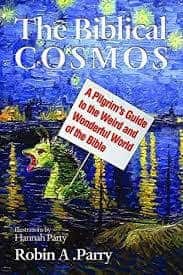 Do you want a book that describes how the biblical writers themselves actually understood the cosmos? Of course you do. What a dumb question.
Do you want a book that describes how the biblical writers themselves actually understood the cosmos? Of course you do. What a dumb question.
Well, do you want that book to deal honestly with ancient data instead of “defending” the Bible, while at the same time being sensitive to more conservative readers? Sure you do.
And would you want that book to be actually short (about 200 pages), readable, with pictures, and even a bit funny now and then? “Yes of course, Pete. Who wouldn’t? But how can this be? Such a thing has never been done.”
And now what if I told you that a book like this actually exists? You’d be so happy, you couldn’t even. You’d gladly sell half your library in order to buy it.
Well, the book does exist and it doesn’t cost half your library. It’s called The Biblical Cosmos: A Pilgrim’s Guide to the Weird and Wonderful World of the Bible by Robin A. Parry (Ph.D., University of Gloucestershire), whose previous books include Lamentations
, The Evangelical Universalist
(under the pseudonym Gregory MacDonald), Universal Salvation?: The Current Debate
(ed.), and Deep Church Rising
(with Andrew G. Walker). He is also featured in Kevin Miller’s documentary Hellbound?
I read the book in prepublication form last year, was proud to endorse it, and couldn’t wait for it to see the light of day. A book like this is sorely needed because it does what no other book I know of does, at least not nearly as well and with as much transparency.
Parry walks his readers through a tour of the ancient cosmos–the cosmos as it was understood by the Old Testament writers–and he does so fully availing himself of the current state of modern critical scholarship. (He has an admirable ability to explain complex issues clearly and quickly.)
On this point, many treatments within evangelicalism falter because, sooner or later, they hit a doctrinal ceiling and arc toward an apologetically oriented engagement with the ancient Near East, wishing to keep some distance between the biblical presentation of the cosmos and those of Israel’s contemporaries and predecessors.
But Parry doesn’t arc toward apologetics. At all. But neither is he in your face. He writes with sensitivity for conservative readers who are not as far along in processing this information as he is.
This would be enough to make me want to assign this book at both the Christian college and seminary levels.
But what makes Parry’s book even more valuable is how he brings forward this contextually informed reading of the Old Testament into a deeper understanding of the theology of the New Testament and how Christians today can “enter” this biblical cosmos for themselves.
The key for Parry is in seeing the ancient Israelite depictions of the earth (chapter 1) and the heavens (chapter 2) as reflective of God’s Temple, which is further concretized in the person and work of Christ (chapter 3). That is ultimately the “biblical cosmos” that scripture offers Christians today.
If Parry’s audience and his intentions are kept in view, no who understands representations of the cosmos in antiquity will have much if anything to quibble with. And those who might have asked in the past whether there is ever any practical theological payoff for understanding the ancient world of the Bible will do so no longer.
The ancient Near Eastern context of the Old Testament is not a mere incidental covering to be removed and discarded to reveal the true divine message beneath. Rather, that context forms the very substance of how the ancient biblical writers understood their world and the God they worshipped.
The ancient context touches the theology of the biblical writers not here and there, but at every point. And any serious theological engagement with scripture will have to embrace that contextually driven ancient message–not only for describing the theology of the Bible but for capturing the imagination of Christians today as they seek to live truly biblically.
Parry pulls this off.
